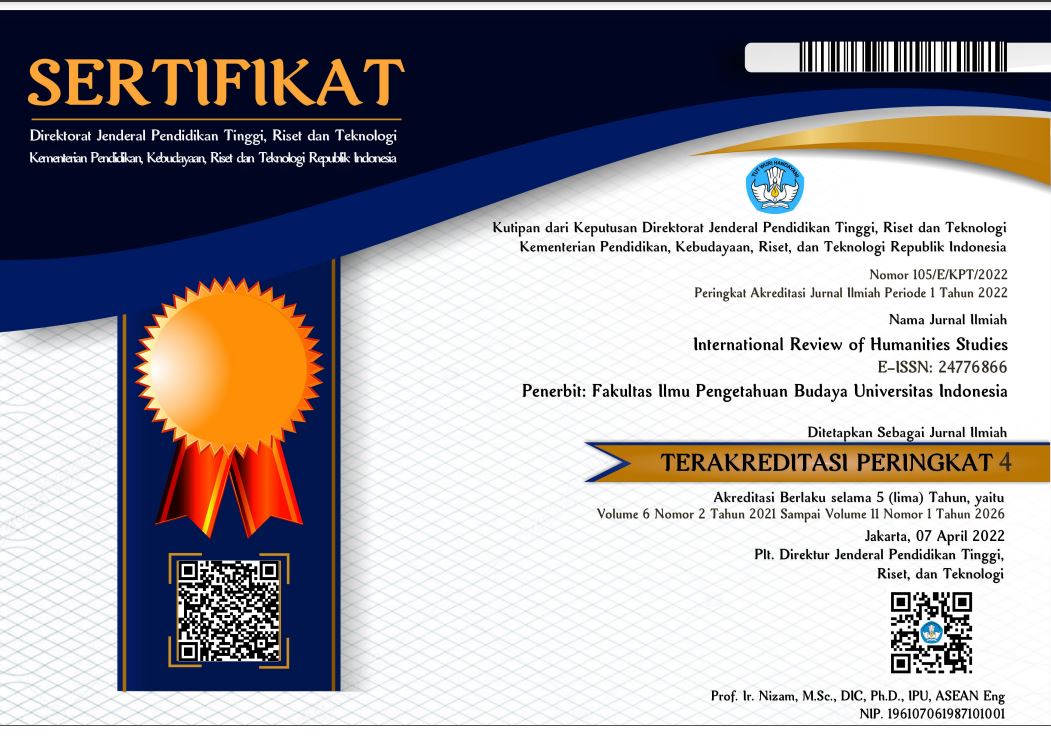International Review of Humanities Studies

Abstract
The horror genre is notorious for sexist depictions of female heroines, which heavily imposes traditional gender stereotypes. This paper analyses Goosebumps (2015) and Goosebumps: Haunted Halloween (2018), which are the movie adaptations of R.L Stine’s horror book series. It aims to see the possibility of the female heroines and male heroes to defy conventional gender stereotypes and determine the female heroines’ agency as horror movies tend to objectify the female characters. This paper uses the Cult of True Womanhood (Welter, 1966), Male Gender Role Identity (Pleck, 1981) and representation theory (Hall, 1997) to analyse the dialogues and interaction of the characters, and the agencies of the female heroines in the two movies. This research shows the apparent ambivalence portrayals as the text often contradicts the characters’ depiction in the earlier part of the film and the ending. In the beginning of the movies, the female heroines are depicted as empowered and independent, but as the story progresses, they become characters that need male heroes’ help and support to overcome problems.
References
Amancio, L. (1993). Stereotypes as Ideologies. The case of Gender Categories. Revista de Psicología Social, 8(2), 163–170. https://doi.org/10.1080/02134748.1993.10821677
Baker, K., & Raney, A. A. (2007). Equally Super?: Gender-Role Stereotyping of Superheroes in Children’s Animated Programs. Mass Communication and Society, 10(1), 25–41. https://doi.org/10.1080/15205430709337003
Barker, C. (2003). Cultural Studies: Theory and Practice (1st ed.) [E-book]. SAGE Publications Ltd. https://www.semanticscholar.org/paper/Cultural-studies-%3A-theory-and-practice-Barker-Willis/db066a5f92a0f95cf799ad37dce2ed12cc77c8f3
Brannon, R. (2003). Gender: Psychological Perspectives. Taylor & Francis. 159-185. http://www.ablongman.com/partners_in_psych/PDFs/Brannon/Brannon_ch07.pdf
Brewer, C. (2009). The Stereotypic Portrayal of Women in Slasher Films: Then versus Now". LSU Master's Theses. 56. https://digitalcommons.lsu.edu/gradschool_theses/56
Bond, A. (2009). Skeletons, Rag Dolls, and Ambiguous Swamp Creatures: Gender in Tim
Burton’s The Nightmare Before Christmas. Dialogues@RU: A Journal of Undergraduate Research, 4. https://dialogues.rutgers.edu/journals/51-skeletons-rag-dolls-and-ambiguous-swamp-creatures-gender-in-tim-burton-s-the-nightmare-before-ch/file
Broverman, I. K., Vogel, S. R., Broverman, D. M., Clarkson, F. E., & Rosenkrantz, P. S. (1972). Sex-Role Stereotypes: A Current Appraisal. Journal of Social Issues, 28(2), 59–78. https://doi.org/10.1111/j.1540-4560.1972.tb00018.x
Clover, C. J. (1987). Her Body, Himself: Gender in the Slasher Film. Representations, 20, 187–228. https://doi.org/10.2307/2928507
Cruz, L. (2015, October 21). The Biggest Problem With the Film Adaptation of R. L. Stine's Goosebumps Series. The Atlantic. https://www.theatlantic.com/entertainment/archive/2015/10/the-scariest-part-about-goosebumps/411349/
Curtis, J. (2016). Why Were You Born?: An Analysis of the Anti-Feminist Implications of the
Film Adaptation of Coraline. Gender Forum. 57. https://www.researchgate.net/publication/296486285_Why_Were_You_Born_An_Analysis_of_the_Anti-Feminist_Implications_of_the_Film_Adaptation_of_Coraline
De Beauvoir, S. (1989). The Second Sex. New York: Vintage Books
Dubois, D. (2001). “Seeing the Female Body Differently”: Gender issues in The Silence of the Lambs. Journal of Gender Studies, 10(3), 297–310. https://doi.org/10.1080/09589230120086502
Eagly, A. H., & Steffen, V. J. (1984). Gender stereotypes stem from the distribution of women and men into social roles. Journal of Personality and Social Psychology, 46(4), 735–754. https://doi.org/10.1037/0022-3514.46.4.735
Eagly, A. H., & Wood, W. (2016). Social Role Theory of Sex Differences. The Wiley Blackwell Encyclopedia of Gender and Sexuality Studies, 1–3. https://doi.org/10.1002/9781118663219.wbegss183
Hall, S. (1997). Representation. Representation: Cultural representations and signifying practices. London: Sage in association with the Open University.
Freeland, C. (2002). The Naked And The Undead: Evil And The Appeal Of Horror (Thinking Through Cinema). Routledge.
Kilmartin, C. (1994). Masculine Self. Sloan Publishing.
Krahn, K. M. (2015). Reel women: Gender stereotypes in film. Master’s Theses and Doctoral Dissertations. Published. http://commons.emich.edu/theses/636
Kvaran, K. M. (2016). “You’re All Doomed!” A Socioeconomic Analysis of Slasher Films. Journal of American Studies, 50(4), 953–970. https://doi.org/10.1017/s0021875815002674
Letterman, R. (Director). (2015). Goosebumps [Film]. Sonny Pictures Releasing.
Lippmann, W. (1988). Public opinion. Brace and Company. https://monoskop.org/images/b/bf/Lippman_Walter_Public_Opinion.pdf
Hanna, O. (2019). Harry Potter and the Fat Stereotypes (Dissertation). http://urn.kb.se/resolve?urn=urn:nbn:se:lnu:diva-79683
Prentice, D. A., & Carranza, E. (2002). What Women and Men Should Be, Shouldn’t be, are Allowed to be, and don’t Have to Be: The Contents of Prescriptive Gender Stereotypes. Psychology of Women Quarterly, 26(4), 269–281. https://doi.org/10.1111/1471-6402.t01-1-00066
Rieser, K. (2001). Masculinity and Monstrosity. Men and Masculinities, 3(4), 370–392. https://doi.org/10.1177/1097184x01003004002
Rummell, C. M., & Levant, R. F. (2014). Masculine gender role discrepancy strain and self-esteem. Psychology of Men & Masculinity, 15(4), 419–426. https://doi.org/10.1037/a0035304
Kamil Sa'eed, M. (2019). The Representation of Women in the Horror Movies: A Study in Selected Horror Movies. Communication and Linguistics Studies, 5(1), 14. https://doi.org/10.11648/j.cls.20190501.13
Sandel, A. (Director). (2018). Goosebumps: Haunted Halloween [Film]. Sony Pictures Releasing
Scholastic (2008), Sony Gets Goosebumps: Scholastic’s Bestselling Book Series to Be Adapted into Feature Film | Scholastic Media Room. Scholastic. http://mediaroom.scholastic.com/node/67
Weaver, A. D., Ménard, A. D., Cabrera, C., & Taylor, A. (2015). Embodying the moral code? Thirty years of Final Girls in slasher films. Psychology of Popular Media Culture, 4(1), 31–46. https://doi.org/10.1037/ppm0000006
Welter, B. (1966). The Cult of True Womanhood: 1820–1860. American Quarterly, 18(2), 151. https://doi.org/10.2307/2711179
Žuvela, A. (2018). Representation of Women in Films: „Psycho“ (1960), „The Silence of the
Lambs“ (1991), „Titanic“ (1997) and „Skyfall“ (2012). https://urn.nsk.hr/urn:nbn:hr:162:223315
Lensa https://jurnal.unimus.ac.id/index.php/lensa/about/submissions#authorGuidelines
Litera https://journal.uny.ac.id/index.php/litera/issue/view/2211
Lingua https://journal.unnes.ac.id/nju/index.php/lingua
Kajian Linguistik dan Sastra https://journals.ums.ac.id/index.php/kls/about/editorialPolicies#focusAndScope
Recommended Citation
Kardono, Tyasyifa Wimahavinda and Hapsarani, Dhita
(2023)
"AMBIVALENCE IN GENDER PORTRAYALS IN GOOSEBUMPS (2015) AND GOOSEBUMPS: HAUNTED HALLOWEEN (2018),"
International Review of Humanities Studies: Vol. 8:
No.
1, Article 23.
DOI: 10.7454/irhs.v8i1.1022
Available at:
https://scholarhub.ui.ac.id/irhs/vol8/iss1/23


